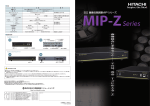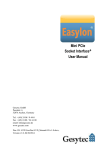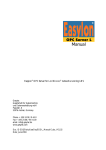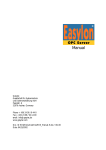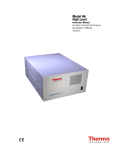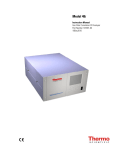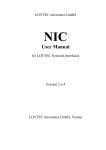Download User Manual
Transcript
PCI Interface+ Manual Gesytec GmbH Pascalstr. 6 52076 Aachen, Germany Tel. + (49) 24 08 / 9 44-0 Fax + (49) 24 08 / 94 4-100 email: [email protected] http://www.gesytec.com Doc. ID: LVP/UserDoc/LVP_Manual-E-v1.3.doc, Version v1.3, 2.8.2010 Easylon PCI Interface+ User Manual This manual … … provides you with all the information which you will require to use the Easylon® PCI Interface+ card. However, this manual will neither explain aspects of Echelon's® LONWORKS® technology, nor details of the EIA/ANSI 709.1 standard on which this product is based, nor Echelon's Microprocessor Interface Program (MIP). Details concerning the Easylon VNI Interface PCI network driver, which has been designed in accordance with the driver specifications of the Echelon Corporation are not part of this documentation. For further information on the LONWORKS technology please refer to the extensive documentation provided by Echelon. Especially Echelon's "LONWORKS Host Application Programmer's Guide" will be required if applications are to be developed using Gesytec's Easylon Interfaces as a network interface. After a general presentation of the Easylon PCI Interface+ card in Chapter 1, Chapter 2 describes the necessary steps to install the card. Chapter 3 contains a general technical description. LVP/UserDoc/LVP_Manual-E-v1.3.doc Chapter 4, “Programming Instructions”, contains the information which will be of importance, should you wish to develop your own network driver software for the Easylon Interface+. This documentation is subject to changes without notice. Gesytec assumes no responsibility or liability for any errors or inaccuracies that may appear in this document. Gesytec shall have no liability or responsibility to the original purchaser or any other person or entity with respect to any claim, loss, liability, or damage caused or alleged to be caused directly or indirectly by any Gesytec product or the accompanying documentation. Easylon is registered trademark of Gesytec GmbH. Echelon, LON, LONWORKS, and NEURON are registered trademarks of Echelon Corporation. Windows is a registered trademark of Microsoft. Other names may be trademarks of their respective companies. 2/19 Easylon PCI Interface+ Manual Contents Contents 1 Product Information ..........................................................................................................4 1.1 Variants ..................................................................................................................5 1.2 Scope of Delivery ..................................................................................................5 1.3 1.3.1 1.3.2 Overview ................................................................................................................5 VNI (Virtual Network Interface) ...........................................................................6 MIP ........................................................................................................................6 2 Installation ..........................................................................................................................7 2.1 Insertion of the Card ..............................................................................................7 2.2 2.2.1 2.2.1.1 2.2.1.2 2.2.1.3 2.2.1.4 2.2.1.5 2.2.2 2.2.3 Driver Installation ..................................................................................................7 Driver for Windows Operating System (WDM Drivers) ......................................8 Installation using the Windows Assistant ..............................................................8 Manual Installation and Update .............................................................................8 Driver Instances .....................................................................................................8 Parameter Setting ...................................................................................................9 De installation ......................................................................................................12 EasyCheck – Test Utility for Windows Drivers ..................................................12 Windows and 16 Bit Applications .......................................................................12 3 Technical Description ......................................................................................................14 3.1 Network Interface ................................................................................................14 3.2 Bus Interface ........................................................................................................14 3.3 Connector Pin Assignment ..................................................................................14 3.4 Status LED ...........................................................................................................15 3.5 Technical Specification ........................................................................................16 3.6 Electromagnetic Compatibility ............................................................................16 4 Programming Instructions ..............................................................................................17 4.1 LONWORKS Network Node ..................................................................................17 LVP/UserDoc/LVP_Manual-E-v1.3.doc 5 List of Figures ...................................................................................................................18 6 List of Tables ....................................................................................................................18 7 Index ..................................................................................................................................19 3/19 Easylon PCI Interface+ Manual 1 Product Information Product Information This manual describes the Easylon Interface Card: Easylon PCI Interface+, Card for 32-Bit PCI Bus Slots. (1) Service button (2) Status LED (3) Screw-plug terminal (TPT and FTT 1 variants only) (4) 9 pin D-type connector LVP/UserDoc/LVP_Manual-E-v1.3.doc Figure 1-1 1 Easylon PCI Interface+ TPT = transformer coupled twisted pair, FTT = free topology transceiver 4/19 Easylon PCI Interface+ Manual 1.1 Product Information Variants The following variants of the Easylon PCI Interface+ are currently available and are described in this documentation. Each variant is identifiable by a type code sticker on the rear of the card. Type Code Order Code Network Interface Type LVP.CAA LVP.DAA LVP.AAA P.V10202 P.V10203 P.V10204 TP/XF-1250 RS-485 FTT Table 1-1 1.2 Scope of Delivery • PC plug-in card • Mounting instruction • Installation and documentation disk (CD-ROM) with – network drivers for 32 bit and 64 bit versions of Windows XP, Vista, 7, Server 2003, Server 2008, Server 2008 R2. Easylon RNI Software for remote LONWORKS access EasyCheck utility for Easylon Interfaces – WLDV32.DLL – This documentation – – 1.3 Variants, order-codes and type identifiers Overview LVP/UserDoc/LVP_Manual-E-v1.3.doc The Easylon PCI Interface+ is a network interface link between a PCI bus computer and a control network following the EIA709.1 standard or the LONWORKS specifications. Variants are available for connection via transformer coupled twisted pair (TP/XF), free topology (FTT) transceivers and for EIA-485 serial connection. As an Easylon Interface+ the network interface card realizes the parallel access of several applications to the network. Thus, the card can be used with the Easylon Analyzer, allowing protocol analysis while other applications are continued. The Easylon PCI Interface+ is provided with a service button and LED. In the TP/XF and FTT variants, the card is equipped with two connectors, either of which can be used: – 9 pin D-type connector 5/19 Easylon PCI Interface+ Manual – 1.3.1 Product Information 2 pin screw-plug terminal VNI (Virtual Network Interface) Easylon Interfaces+ are so called Virtual Network Interfaces (VNI). With VNI Echelon defined a transparent mode of operation for LonWorks interfaces. In this mode LonTalk packet are not pre processed on the interface device, but the PC realized the complete network access. Thus the applications running on the PC receive an send the messages. VNI interfaces overcome several limitations of the conventional interfaces using MIP or NSI firmware. For instance they offer an increased performance. Easylon VNI interfaces are compatible with the Echelon VNI interfaces and can be used with LNS based software such as LonMaker for Windows without problems. 1.3.2 MIP LVP/UserDoc/LVP_Manual-E-v1.3.doc The Neuron Chip used on the conventional network interface requires a firmware to realize the interface functionality. The de facto standard was the MIP firmware. Many applications still use the functionality of this firmware, which realizes layers 3–5 of the LonTalk protocol, namely network, transport and session. Using the drivers of the Easylon VNI Interfaces up to 8 logical MIP interfaces can be used with one interface card, i.e. an Easylon Interface+ replaces 8 standard MIP interface cards. 6/19 Easylon PCI Interface+ Manual Technical Description 2 Installation Installation of the Easylon PCI Interface+ is carried out in two steps: 1. Insertion of the card into the PC 2. Installation of the network driver The external interface files (.xif) for the different card variants can be found on the accompanying CD-ROM. Which ".xif"-file belongs to which variant can be found in Table 4.1. 2.1 Insertion of the Card When inserting the Easylon PCI Interface+ card in your computer, please be sure to observe all the computer manufacturer's instructions regarding the insertion of additional interface cards. The Easylon PCI Interface+ card is to be inserted into a vacant 32-Bit PCI slot while the computer is switched off. The address and the interrupt are automatically assigned by the computer’s PCI BIOS. Please refer to section 3.3 for information regarding the connector pin assignments for connection to the LONWORKS network. 2.2 Driver Installation LVP/UserDoc/LVP_Manual-E-v1.3.doc Drivers for different operating systems are available for the Easylon PCI Interface. Currently these are Windows 2000, XP, Vista and 7 and the Windows Server OS 2003, 2008 und 2008 R2. The drivers support both, the 32 and the 64 bit version of these operating systems. Latest driver versions you can downloadvia the Easylon Support pages of our web site: www.gesytec.com Installtion is describe in the following sections: Windows operating systems chapter 2.2.1 16-Bit driver under 32-bit Windows chapter 2.2.3 This section also describes in short the diagnosis utility „EasyCheck“ which can be installed separately from CD. 7/19 Easylon PCI Interface+ Manual Technical Description The “Driver and Documentation” CD will lead you to the installation of drivers for different operating systems (OS). However, all setups can as well be started manually for each OS and the respective interface card directly from the CD. 2.2.1 Driver for Windows Operating System (WDM Drivers) This section describes installation and setup of the Easylon Interface card drivers for the Windows operating system from Windows XP onwards. The setup program is using the same WDM driver (Windows Driver Model) for all operating systems. Note: For installation you can either use the Windows assistant or the program FastUpd.exe for manual installation. The latter is much more directly and especially helpful if you have to install several instances of the driver. Finally de-installation of the driver is explained 2.2.1.1 Installation using the Windows Assistant After the Easylon Interface has been mounted Windows will recognize the new device and start the hardware assistant. If Windows should not find the driver on the “Drivers and Documentation” CD or the driver should be elsewhere, please select the appropriate drive and select the setup file „LvpWdm.inf“ and the driver „Gesytec LVP EIA-709 WDM Driver PCI“ from the LVP directory. 2.2.1.2 Manual Installation and Update The easiest way to install the driver is to ignore the hardware assistant and run FastUpd.exe or FastUpd64.exe 2 from the “Lvp” folder of the CD-ROM. The same program you will use to update an existing driver. LVP/UserDoc/LVP_Manual-E-v1.3.doc 2.2.1.3 Driver Instances The driver for the Easylon VNI Interfaces consists of a basic part for the interface hardware “LVPx-y” 3 and of up to eight logical VNI drivers „LVPx-y-Vniz“ and up to eight logical MIP drivers„LVPx-y-Mipz“. These driver instances can be used like independent network interfaces. 2 For 64-bit systems 3 x-y are the PCI Bus number und slot number 8/19 Easylon PCI Interface+ Manual Technical Description For each logical driver instance an individual node-id (unique identification corresponding to the Neuron-ID) is used. VNI and MIP drivers with identical last digit z will be assigned the same node-id. There is a maximum of 8 node-ids available for each interface device. 2.2.1.4 Parameter Setting Settings for the Easylon Interfaces can be parameterized in the Device Manager. This is especially required if several diver instances are used. Select the respective interface board under LON Adapters and modify the settings. LVP/UserDoc/LVP_Manual-E-v1.3.doc The „Advanced“ TAB allows setting of individual properties. 9/19 Easylon PCI Interface+ Manual Technical Description Parameters for interface device. Debug Flag This field contains a DWORD in hexadecimal notation of different flags for debug purposes. Usually it is set to 0 (= not existing). By setting the single bits certain debug features can be turned on. Currently bits 1 and 3 are supported: NOTE: Bit 1: Telegrams at the interface between PC and interface hardware are displayed in the debug output. Bit 3: CREATE and CLOSE of the driver are displayed in the debug output. The Debug Output can be displayed using, for example, the program DebugView, available at www.sysinternals.com. LVP/UserDoc/LVP_Manual-E-v1.3.doc Number of Mip-Interfaces The number of virtual Mip-Interfaces can be set here (0 – 8, default = 2). Number of VNI-Interfaces The number of virtual VNI-Interfaces can be set here (0 – 8, default = 1). 10/19 Easylon PCI Interface+ Manual Technical Description ATTENTION There are 8 node-IDs available for each interface device. These have to be assigned appropriately to the applications using the device either as VNI or as a MIP interface. If, for example, a VNI application is using the instance LVPx-yVni0 with its corresponding node-id, a MIP application must not use the instance LVPx-y-Mip0. VNI application (e.g. LNS) usually generate a node-id of their own, which will then be additional to the 8 standard node-id provided by the interface device. Permitted Power Saving Usually the Easylon Interfaces allow the standby mode as well as the hibernate mode with applications running. However, in certain operating conditions problems may arise if the PC, with a LON application running, automatically changes to hibernate or standby mode. This can be turned off by selecting “None”. Parameters for logical instance LVP/UserDoc/LVP_Manual-E-v1.3.doc Adapter Name An arbitrary name can be chosen freely (e.g. building 7). NOTE This name must not be used by another instance. If the name is already in use, the device will not start (code 10). 11/19 Easylon PCI Interface+ Manual Technical Description Debug Flag This field contains a DWORD in hexadecimal notation of different flags for debug purposes. Usually it is set to 0 (= not existing). By setting the single bits certain debug features can be turned on. Currently bits 0, 1 and 3 are supported: 2.2.1.5 Bit 0: LON telegrams at the interface from and to the application are displayed in the debug output. Bit 1: Telegrams at the interface between PC and interface hardware are displayed in the debug output. Bit 3: CREATE and CLOSE) of the driver are displayed in the debug output. De installation WDM drivers are de installed using the “Device Manager”. Among “LON Adapters” select the “Gesytec LVPx-yy” driver and click “de-install”. 2.2.2 EasyCheck – Test Utility for Windows Drivers In addition to the drivers, the test utility “EasyCheck” can be installed in the respective program directory (default: : \Easylon\Lpx ). The program checks interface and software environment and displays information, from which can be concluded on the reasons for problems in connection with the interface. EasyCheck runs an analysis of the system’s software. It will open the selected interface, check the driver version and display it. By sending a “query status” command the communication with the hardware is tested. Using the “read memory” command the utility will show if the device is running MIP or NSI firmware. Properly installed Easylon Interfaces will send a corresponding answer. 2.2.3 Windows and 16 Bit Applications The Windows driver for the 32 bit Windows versions also provides a 16 bit interface. (Unfortunately Microsoft does not support this in the 64 bit versions.) To use it, the following entry has to be made in the file „config.nt“, usually found in the windows\system32 directory: LVP/UserDoc/LVP_Manual-E-v1.3.doc Device=%SystemRoot%\system32\ lpxdos.exe –Llvpwdm0-14-Mip0 The 32 bit LON device used is specified by the optional –L or /L parameter: /Lname name = 12/19 Easylon PCI Interface+ Manual Technical Description lvxwdm5-0-Mip0 for device LVX wth PCIe-bus number 5, PCI device number 0 and instance 0 lvuwdm1-2-Mip0 for device LVU at USB host controller 1 and with port number 2 at USB root hub lvpwdm0-14-Mip0 for device LVP with PCI-Bus number 0, PCI device number 14 and Instance 0 Note: lpcwdm340 für Device LPC mit I/Oport Adresse 340 lppwdm0-14 für Device LPP mit PCI-Bus-Nummer 0 und PCI Device-Nummer 14 lonusb1-2 für Device LONUSB an USB Hostcontroller 1 und mit der Portnummer 2 am USB-Root-Hub. lpcdrv für Device EasyLPC mit der Nummer 1 lpp1 für Device EasyLPP mit der Nummer 1 Two subsequent “l” characters have to be entered, one indicating the parameter L, the second as first character of the name: –Llxxxx The 16 bit LON device used is specified by the following optional parameter: /Dn with n = 1...9 for LON1 to LON9 LVP/UserDoc/LVP_Manual-E-v1.3.doc Without this parameter, the interface will be assigned the first unused name starting with “LON1”. 13/19 Easylon PCI Interface+ Manual 3 3.1 Technical Description Technical Description Network Interface Easylon Interface+ cards are using an FPGA for accessing the control network. The programming is loaded at start up. 512 kbytes RAM are available to the FPGA as network buffer for transmit and receive. For use in protocol analysis each packet received is transmitted to the application with timestamp of 1 ms accuracy. The FPGA is connected to the computer bus. Eight node-ids are available on the interface for identification within the control network (cf. “Driver Instances”). The interface status is signaled by a status LED. The Service push button is read by the driver software. 3.2 Bus Interface The PCI Bus interface has been developed as 32-Bit I/O interface according to the “PCI Local Bus Specification, Version 2.2”. It corresponds to the PCIx (not to the PCIexpress) standard. The Easylon PCI Interface+ card will be assigned the I/O addresses by the PCI BIOS. The necessary addresses consist of one address for data transfer between the PC and the network interface card, one address for status queries and control of the NEURON Chip, and one address for the watcher. 3.3 Connector Pin Assignment LVP/UserDoc/LVP_Manual-E-v1.3.doc The Easylon PCI Interface+ provides a 9-pin D-type connector (Figure 1-1 ) for network connection. In the TPT/XF and FTT variants, the card is additionally equipped with a 2 pin screw-plug terminal (Figure 1-1 }), which can be used alternatively. 14/19 Easylon PCI Interface+ Manual Connector type 9-pin D-type 2-pin screw-plug Terminal Table 3-1 Pin 1 2 3 4 5 6 7 8 9 1 2 Signal data data — — — — — — — data data Remark Data Data Reserved Reserved Reserved Reserved Reserved Reserved Reserved Data Data Connector pin assignment for TPT/XF and FTT network connection Connector type Pin Signal Remark 9 pin D-type 1 2 3 4 5 6 — — DASA— +5 V 7 0V 8 9 DA+ SA+ Table 3-2 3.4 Technical Description Reserved Reserved Data RTS – Reserved U+ supply voltage, electrically isolated U– supply voltage, electrically isolated Data RTS + Connector pin assignment for EIA-485 network connection Status LED LVP/UserDoc/LVP_Manual-E-v1.3.doc The status LED (Figure 1-1 (2)) signals the network traffic. 15/19 Easylon PCI Interface+ Manual 3.5 Technical Description Technical Specification Bus Interface 32 bit Data (I/O), according to „PCI Local Bus Specification, Version 2.2“ supporting 3.3 V and 5 V systems Network Interface FPGA memory 512 KByte SRAM RAM 9 KByte Order Code* P.V10202 Network Interface TP/XF1250 P.V10203 EIA-485, 39 kbps electr. isol. FTT-10A 78 kbps P.V10204 Transmission Rate 1.25 Mbps Network Connector Protection 9-pin D-Type + 2 pin screw-plug terminal 9-Pin D-Type 9-pin D-Type + 2 pin screw-plug terminal * cf. Table 1.1 for variant identifiers on the card. Voltage Supply 5 V, from PC Power consumption typically 1.5 W Temperature operation storage 0 °C – 50 °C -20 °C – +60 °C Sparc-gaps Zener Diode Sparc-gaps EMC LVP/UserDoc/LVP_Manual-E-v1.3.doc 3.6 Immunity EN 61 000-6-2, (industrial) Emission EN 55 022 A/B, (home and industrial) Humidity according to DIN 40040, class F Dimensions 127 mm x 107 mm, for 32-Bit PCI Slot Electromagnetic Compatibility The Easylon PCI Interface+ is a CE certified product and meets the intent of Directive 2004/108 EC for Electromagnetic Compatibility. Compliance was demonstrated to the following standards: Immunity EN 61 000-6-2, (industrial) Emission EN 55 022 A/B, (home and industrial) 16/19 Easylon PCI Interface+ Manual 4 4.1 Programming Instructions Programming Instructions LONWORKS Network Node Being an EIA-709.1 compatible interface device the Easylon PCI Interface+ card can be used as a network node in a LONWORKS network. The appropriate external interface files (.xif) are on the installation CD-ROM. Which .xif-file is describing which interface card variant is shown in the following table: Network Interface Transmission Rate TP/XF 78 kbps TP/XF 1.25 Mbps EIA-485, electr. isol. 39 kbps FTT 78 kbps lolp072f.xif lolp073f.xif lolp074f.xif lolp075f.xif Card variants and .xif files LVP/UserDoc/LVP_Manual-E-v1.3.doc Table 4-1 XIF File 17/19 Easylon PCI Interface+ Manual User Manual List of Figures Figure 1-1 Easylon PCI Interface+ .......................................................................................... 4 6 List of Tables Table 1-1 Variants, order-codes and type identifiers ............................................................. 5 Table 3-1 Connector pin assignment for TPT/XF and FTT network connection ................ 15 Table 3-2 Connector pin assignment for EIA-485 network connection ............................. 15 Table 4-1 Card variants and .xif files ................................................................................... 17 LVP/UserDoc/LVP_Manual-E-v1.3.doc 5 18/19 Easylon PCI Interface+ Manual 7 Index Index network interface 14 Number of Mip-Interfaces 10 Number of VNI-Interfaces 10 PCI-Bus interface 14 permitted power saving 11 power consumption 16 programming 17 scope of delivery 5 screw-plug terminal 15 service button 4 status LED 4, 15 temperature 16 variants 5 LVP/UserDoc/LVP_Manual-E-v1.3.doc .xif 7 16 bit applications 12 Adapter Name 11 connector pin assignment EIA-485 15 TPT/XF, FTT 15 Debug Flag 10, 12 driver 7 driver instances 8 D-type connector 4 EasyCheck 12 humidity 16 installation 7 memory 16 19/19





















